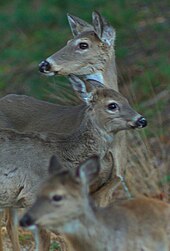
This article seeks to serve as a field-guide, central repository, and listing for the flora and fauna of the US state of North Carolina and surrounding territories.
State ecology
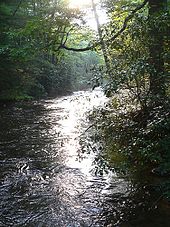
North Carolina's geography is usually divided into three biomes: Coastal, Piedmont, and the Appalachian Mountains.
North Carolina is the most ecologically unique state in the southeast because its borders contain sub-tropical, temperate, and boreal habitats. Although the state is at temperate latitudes, the Appalachian Mountains and the Gulf Stream influence climate and, hence, the vegetation (flora) and animals (fauna).
Coastal region
Located in eastern North Carolina, the coastal region is much warmer and more humid. The climate is humid subtropical and the geography is flat coastal plain.
Piedmont
This region includes the Charlotte metropolitan area and urban biomes of Raleigh and Durham, as well as a large area of semi-mountainous, rolling hills. The climate is humid subtropical and the geography is rolling, gentle hills and flat valleys. The Piedmont ranges from about 300–400 feet (90–120 m) elevation in the east to over 1,000 feet (300 m) in the west.
Mountains
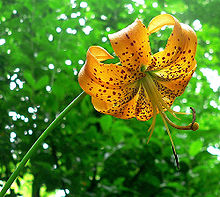
The mountainous region has a climate of humid continental and its geography is the Appalachian Mountains with elevations between 1500 and more than 6000 feet.
Animal life
Mammals
E = Endangered
Opossums:
- Virginia opossum, Didelphis virginiana
Armadillos:
- Nine-banded armadillo, Dasypus novemcinctus
Rodents:
- North American beaver, Castor canadensis reintroduced
- Northern flying squirrel, Glaucomys sabrinus (Carolina northern flying squirrel, G. s. coloratus E)
- Southern flying squirrel, Glaucomys volans
- Groundhog, Marmota monax
- Rock vole, Microtus chrotorrhinus
- Meadow vole, Microtus pennsylvanicus
- Woodland vole, Microtus pinetorum
- Southern red-backed vole Myodes gapperi
- Woodland jumping mouse Napaeozapus insignis
- Eastern woodrat, Neotoma floridana
- Golden mouse Ochrotomys nuttalli
- Muskrat, Ondatra zibethicus
- Marsh rice rat, Oryzomys palustris
- Cotton mouse, Peromyscus gossypinus
- White-footed mouse, Peromyscus leucopus
- Eastern deermouse, Peromyscus maniculatus
- Oldfield mouse, Peromyscus polionotus
- Eastern harvest mouse, Reithrodontomys humulis
- Eastern gray squirrel, Sciurus carolinensis (state mammal)
- Fox squirrel, Sciurus niger
- Hispid cotton rat Sigmodon hispidus
- Southern bog lemming, Synaptomys cooperi
- Eastern chipmunk, Tamias striatus
- American red squirrel, Tamiasciurus hudsonicus
Lagomorphs:
- Snowshoe hare, Lepus americanus extirpated
- Swamp rabbit, Sylvilagus aquaticus
- Eastern cottontail, Sylvilagus floridanus
- Appalachian cottontail, Sylvilagus obscurus
- Marsh rabbit, Sylvilagus palustris
Eulipotyphlans:
- Star-nosed mole, Condylura cristata
- Eastern mole, Scalopus aquaticus
- Northern short-tailed shrew, Blarina brevicauda
- Southeastern shrew, Sorex longirostris
Bats:
- Townsend's big-eared bat, Corynorhinus townsendii (Virginia big-eared bat, C. t. virginianus E)
- Northern yellow bat Dasypterus intermedius
- Big brown bat, Eptesicus fuscus
- Eastern red bat Lasiurus borealis
- Hoary bat Lasiurus cinereus
- Seminole bat Lasiurus seminolus
- Gray bat, Myotis grisescens E
- Eastern small-footed bat Myotis leibii E
- Northern myotis, Myotis septentrionalis
- Indiana bat, Myotis sodalis E
Carnivorans:
- Coyote, Canis latrans
- Red wolf, Canis rufus E reintroduced
- North American river otter, Lontra canadensis
- Bobcat, Lynx rufus
- Striped skunk, Mephitis mephitis
- Eastern spotted skunk, Spilogale putorius
- Least weasel, Mustela nivalis
- Long-tailed weasel, Neogale frenata
- American mink, Neogale vison
- Fisher, Pekania pennanti extirpated
- Raccoon, Procyon lotor
- Cougar, Puma concolor extirpated
- Eastern cougar, P. c. couguar EX
- Gray fox, Urocyon cinereoargenteus
- American black bear, Ursus americanus
- Red fox, Vulpes vulpes
- Harbor seal, Phoca vitulina
Even-toed ungulates:
- American bison, Bison bison extirpated
- Elk, Cervus canadensis reintroduced
- Eastern elk, C. c. canadensis EX
- Rocky Mountain elk, C. c. nelsoni introduced
- White-tailed deer, Odocoileus virginianus
- Wild boar, Sus scrofa introduced
Birds
Main article: List of birds of North Carolina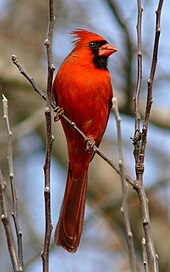
Reptiles
Main article: List of reptiles of North Carolina
Amphibians
Main article: List of amphibians of North Carolina
Frogs are common in the marshy and wet regions of the Piedmont. The frog pictured at left is a Cope's gray treefrog (Hyla chrysocelis) or gray treefrog (H. versicolor). These two species cannot be differentiated except by their call or genetic analysis. However, H. versicolor is rare in the state and likely to not be pictured here. They are most abundant in some northern Piedmont counties. Other frogs of North Carolina include spring peepers, Pseudacris crucifer or Hyla crucifer. Common among Carolina forests, this frog lives in high branches of trees, although it is also seen on the ground and commonly on roadways.
Some common amphibians in North Carolina: two-toed amphiuma, common mudpuppy, dwarf waterdog, eastern lesser siren, greater siren, red-spotted newt, Mabee's salamander, spotted salamander, marbled salamander (state salamander), mole salamander, eastern tiger salamander, southern dusky salamander, dwarf salamander, four-toed salamander, Wehrle's salamander, eastern spadefoot, southern toad, Pine Barrens treefrog (state frog), Cope's gray treefrog, green treefrog, squirrel treefrog, gray treefrog, little grass frog, ornate chorus frog, upland chorus frog, American bullfrog, bronze frog, pickerel frog, southern leopard frog and wood frog.
Fish
Freshwater: bodie bass, Roanoke bass, largemouth bass, rock bass, smallmouth bass, spotted bass, striped bass, white bass, blue catfish, channel catfish, flathead catfish, white catfish, brown bullhead, white perch, yellow perch, chain pickerel, redfin pickerel, American shad, hickory shad, pumpkinseed, redear, bluegill, flier, green sunfish, redbrest, warmouth, brook trout, rainbow trout, brown trout, garfish, bowfin, carp, crappie, freshwater drum, grass carp, kokanee salmon, muskellunge, tiger muskellunge, northern pike, sauger, eastern mosquitofish, smallmouth buffalo, walleye, the endemic Cape Fear shiner.
Saltwater: albacore, amberjack, Atlantic bonito, Atlantic tarpon, bank sea bass, barracuda, bigeye tuna, blackfin tuna, black drum, black sea bass, blacktip shark, bluefish, bluefin tuna, blue marlin, blueline tilefish, bull shark, butterfish, cobia, croaker, dolphinfish, flounder, gag, gray triggerfish, gray trout, hammerhead sharks, hickory shad, hogchoker, hogfish, humping mullet, king mackerel, knobbed porgy, lizardfish, little tunny, mako shark, menhaden, northern puffer, oyster toadfish, pigfish, pinfish, pompano, red drum, red grouper, red snapper, sailfish, scamp, sea mullet, searobin, sheepshead, silver perch, silver snapper, skate, skipjack tuna, spadefish, Spanish mackerel, speckled hind, spottail pinfish, spot, speckled trout, stingray, striped bass, swordfish, tiger shark, vermillion snapper, wahoo, white marlin, white grunt, yellowfin tuna, yellowedge grouper and yellowtail snapper.
Invertebrates
Various insects, jellyfish, millipedes, centipedes, freshwater crayfish and freshwater mollusks.
Spiders: northern black widow (Latrodectus variolus), southern black widow (Latrodectus mactans), false black widow (Steatoda grossa), common house spider (Parasteatoda tepidariorum), yellow garden spider (Argiope aurantia), leafy cob weaver (Theridion frondeum), spiny-backed orbweaver (Gasteracantha cancriformis), white sac spider (Elaver excepta) and orchard orb weaver (Leucauge venusta).
Mantises: Carolina mantis (Stagmomantis carolina)
Hymenoptera: European honey bee (Apis mellifera state insect), American bumblebee (Bombus pensylvanicus), eastern carpenter bee (Xylocopa virginica), red paper wasp (Polistes carolina), eastern cicada killer (Sphecius speciosus), red velvet ant (Dasymutilla occidentalis) and red imported fire ant (Solenopsis invicta).
Odonata: eastern pondhawk (Erythemis simplicicollis).
Lepidopterans: monarch butterfly (Danaus plexippus) and red-spotted purple (Limenitis arthemis).
Plant life
Main article: List of flora of North Carolina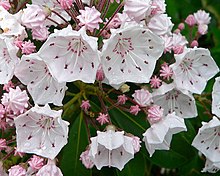
References
- "General Raleigh, NC Information". Retrieved 2018-05-10.
- "Beaver Management in North Carolina - History". North Carolina Wildlife Resources Commission. Archived from the original on April 16, 2010. Retrieved September 5, 2017.
- "NatureServe Explorer 2.0". explorer.natureserve.org. Retrieved 4 November 2022.
- Cochran, Bill (June 17, 2004). "Virginia officials take no joy in elk celebration". The Roanoke Times. Archived from the original on February 1, 2013. Retrieved September 5, 2017.
- Archived February 2, 2007, at the Wayback Machine
- "North Carolina Wildlife Resources Commission". www.ncwildlife.org.
- "AAFT". All-about-fish-teacher.blogspot.com. 2012-06-04. Retrieved 2013-04-22.
- "NCDMF Oyster Sanctuaries". Ncfisheries.net. Retrieved 2013-04-22.
- "Research & Collections". naturalsciences.org.
External links
General interest:
- North Carolina Wildlife Resources Commission
- The North Carolina Gap Analysis Project -- Vertebrate Predicted Distribution Mapping
- Carolina nature
Specific:
- North Carolina Birding Trail
- Herps of NC: Amphibians and Reptiles of North Carolina
- the Savannah River Ecology Laboratory Herpetology Program
- Butterflies of North Carolina
- Common Spiders of North Carolina